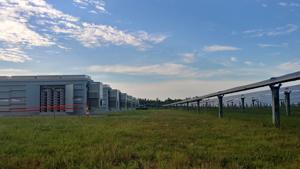New big batteries operational on Dominion Energy electrical grid in Virginia

POWHATAN — In an effort to curb planetary warming, both solar and wind energy are increasingly part of the nation’s energy infrastructure. Energy costs from these sources over their design lifetimes are in decline, as neither requires a regular fuel source after their initial build.
Because the sun does not shine at night and the wind is not consistent, utility scale batteries are beginning to make up the difference to keep the flow of electricity reliable.
Last week, utility scale batteries at Dominion Energy’s Scott Solar facility in Powhatan County went online, meaning the batteries are now actively charging and discharging daily. The battery system is set up on an automatic schedule that can be adjusted as seasons change and the local demand for electricity changes over the course of a day.
Locating the batteries next to the solar farm makes sense for charging them. During the day, the solar panels move with the sun across the sky for optimal solar energy generation, so there are periods when more energy is generated than can be immediately used. This excess energy from the solar panels is rerouted to the batteries for storage and can be used later. In the case of the Scott facility, it is for peaking purposes.
The 12-megawatt battery at the Scott site can power 3,000 homes for up to four hours. While that may not sound like a lot, the batteries are not designed for storing energy when other systems fail. Rather, they are designed to supplement during short, high-demand periods. Imagine the surge in electricity demand late in the afternoon when hundreds of thousands of people are getting home from work and preparing dinner, turning on screens, and changing their air conditioners to a cooler setting.
The batteries are well-suited for this process because current technologies limit how long they can provide power once fully charged. According to Eric Conner, a structural engineer and manager for generation construction at Dominion, it is a more cost-effective way to meet limited, high-demand periods versus building an entirely new generation facility to meet that demand.
In addition to the immediate impact during high-demand periods, these batteries give Dominion real-world experience in understanding precisely how this type of energy storage infrastructure will integrate into its larger electrical grid.
Designed to last 15 to 20 years, these utility scale batteries, called BESS (Battery Energy Storage System) look like nondescript gray shipping containers, about 50 feet long and 8 feet wide. This allows them to be shipped without special oversized permits.
Within each BESS box are smaller components working together to store and release power.
Conner uses a filing cabinet analogy to describe the inner workings. “The individual cells are like folders in a filing cabinet, with 10 cells making up a module, and 17 modules going into a rack.”
These are wired together in a sequence (aka, daisy-chained) to optimize performance.
Locating the batteries adjacent to the solar farm was a straightforward decision. The solar farm has been operational since 2016, with a peak capacity of 17 million watts of power.
To make more sense of that figure, start by converting that number from power to energy: multiply by the amount of time that the power is being used.
On a typical electric bill, energy used is measured in units of kilowatt-hours, or 1,000 watts of power used for one hour. A typical home uses about 30 kilowatt-hours in a day.
The solar farm was developed by Virginia Solar and purchased by Dominion in 2018. Like most solar facilities, these panels are not static, but swivel during the day in order to track the sun as it crosses the sky, getting the most direct sunlight to the panels.
According to Conner, the panels do not need much maintenance. Solar panels generally do not have to be cleaned, as the regular occurrence of rain is enough to wash away any significant impurities on their surfaces. The panels also generate some heat, enough to melt any snow that falls on them during the winter.
And while clouds do impact the amount of sunlight reaching the panels, there is always light reaching the panels on even the cloudiest day. While the power generated is lower on those days, it is far from zero.
Conner acknowledges the current limitations on renewables and the importance of batteries in maintaining a reliable supply of energy.
“The combination of solar and wind is really appealing,” he said. “Because the [offshore] wind also helps offset the peak that the solar has. Wind isn’t producing the most in the middle of the day like solar is. It produces more in the evenings.”
But for those worried about reliability, Dominion’s Jeremy Slayton reminds customers that renewables are a long way from being the only tool in Dominion’s energy toolbox.
“Battery storage is an integral component to the clean energy transition in Virginia,” Slayton said. “In addition to battery storage, combustion turbines play a critical role in keeping the lights on when the sun isn’t shining and the wind isn’t blowing.”
Coal may be on the way out, as Dominion plays to retire the coal units at the Chesterfield Power Station next year. But natural gas is not going away anytime soon.




